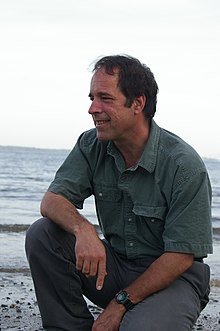Curt Stager
This article may require cleanup to meet Wikipedia's quality standards. The specific problem is: formatting of lists in article. (December 2017) |
Curt Stager | |
|---|---|
 | |
| Born | Jay Curtis Stager July 29, 1956 Lancaster, PA |
| Education | Bowdoin College Duke University |
| Occupation(s) | Professor, author, musician, radio co-host |
| Awards | Carnegie-Case Science Teacher of the Year, New York state Draper-Lussi Endowed Chair in Paleoecology and Lake Ecology |
| Website | [1] |
Jay Curtis Stager (born July 29, 1956) is an author, radio co-host, musician, and professor of natural sciences at
Climate Change Institute[2] at the University of Maine, Orono. His research [3] in Africa and the Adirondacks has focused on the use of lake sediment cores[4] to reconstruct past climates, evolution, and human impacts on ecosystems over centuries to thousands of years. In addition to investigating environmental histories of lakes in Africa, South America, and the United States, he has studied acid rain
recovery in Adirondack lakes, human impacts on Thoreau's Walden Pond, fish evolution in Uganda, megadroughts in the Afro-Asian monsoon region, coral reef ecology in the Bahamas, and exploding lakes in Cameroon.
He received a B.A. in biology and geology from
lake ecology
, and a convention of Catholic Climate Ambassadors at Paul Smith's College in March, 2016.
A YouTube video[6] of Curt playing guitar for a pet crow that appeared online in 2015 has been popular on various websites. He performs frequently on banjo and guitar, was director of Meadowlark Music Camp in Washington, ME, between 1997 and 2010, and co-organized the annual Science Art Music Festival [7] at Paul Smith’s College since 2014.
Selected publications
- Silent Death From Cameroon's Killer Lake. National Geographic (September, 1987).
- Stager, J.C., D.B. Ryves, B.M. Chase, and F.S.R. Pausata. Catastrophic drought in the Afro-Asian monsoon regions during Heinrich Event 1. Science 331: 1299-1302. (2011)
- Deep Future: The Next 100,000 Years of Life on Earth (Saint Martin’s Press; 2011).[8]
- Stager, J.C. and M. Thill. Climate Change in the Adirondacks: What Natural Resource Managers Can Expect and Do. (2010).[9]
- Your Atomic Self: The Invisible Elements That Connect You to Everything Else in the Universe (Saint Martin’s Press; 2014).[10]
- Stager, J.C., L.A. Sporn, M. Johnson, and S. Regalado. Of paleo-genes and perch: What if an "alien" is actually a native? PLOS ONE, doi:10.1371/journal.pone.0119071. (2015)[11]
- Tales of a Warmer Planet. New York Times (November 28, 2015).[12]
- What The Muck of Walden Pond Tells Us About Our Planet. New York Times (January 7, 2017).[13]
- Hidden Heritage. Adirondack Life (June, 2017).
- Still Waters: The Secret World of Lakes (W.W. Norton; in press).
Videos
- "Deep Future." TEDx Perth, Australia, July 13, 2011.
- "Blackbird."
- "Climate Whiplash." Paul Smith's College presentation.
- "Hidden Heritage." Native Americans and environmental history in the Adirondacks.
References
- ^ "Paul Smith's College | The College of the Adirondacks". www.paulsmiths.edu. Retrieved 2017-10-17.
- ^ "Climate Change Institute".
- ^ "AfricaPaleo". sites.google.com. Retrieved 2017-10-17.[permanent dead link]
- ^ "Curt Stager". YouTube.
- ^ "Natural Selections: Conversations on the natural world | NCPR". www.northcountrypublicradio.org. Retrieved 2017-10-17.
- ^ Johnson, Kary. "Blackbird". YouTube.
- ^ "Science Art And Music Festival, Science Talks And The Arts - Sam Fest - Paul Smiths, Ny". SAM Fest. Retrieved 2017-10-17.
- ^ Stager, Curt. "Writings". Archived from the original on 2017-12-14. Retrieved 2017-10-17.
- ^ "Climate Change in the Adirondacks: What Natural Resource Managers Can Expect and Do" (PDF).
- ^ "Home Page". curtstager. Retrieved 2017-10-17.
- PMID 25751263.
- ISSN 0362-4331. Retrieved 2017-10-17.
- ISSN 0362-4331. Retrieved 2017-10-17.
